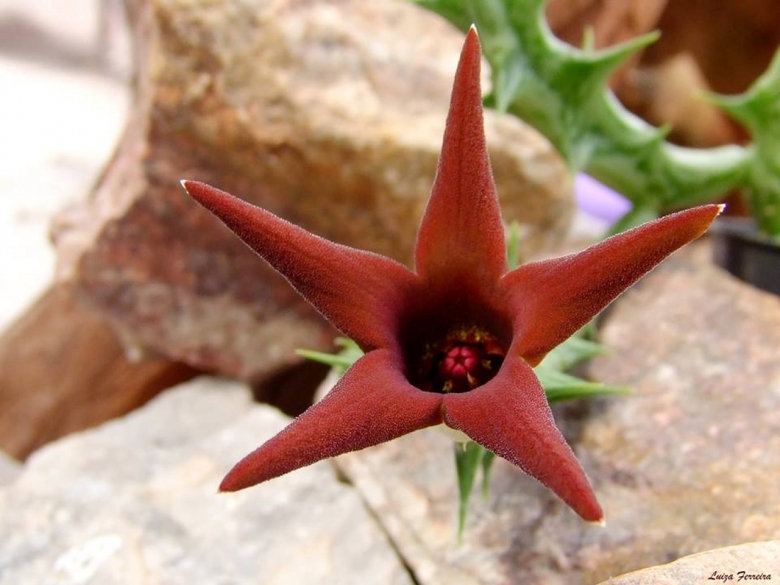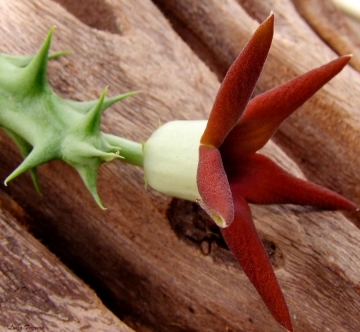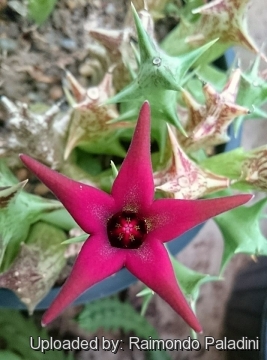Accepted Scientific Name: Orbea deflersiana (Lavranos) Bruyns
Aloe 37: 74 2000

Angolluma deflersiana (Orbea deflersiana) Photo by: Luiza Ferreira
RH 285E Lodar e 3 km, Hadhramaut, Yemen.
Origin and Habitat: Orbea deflersianaSN|30626]]SN|30626]] is widely distributed in the southwestern corner of the Arabian Peninsula, from the southernmost part of Saudi Arabia to the southern parts of Yemen, where it is widespread and quite frequent.
Habitat and ecology: Plants are usually found in rocky areas the shade of Acacia trees and other succulents from the plains at the foot of the escarpment into the foothills of granitic mountain lying close to the Yemen border and rising about 1.670 metres. This mountain attracts mist, cloud and rain.
Synonyms:
Description: Orbea deflersianaSN|30626]]SN|30626]], this another species formerly in Angolluma, is a leafless perennial stem succulent densely clustered or in cushions. Plants are attractive with red mottled stems when grown in good light. Flowers are more or less bell-shaped, dark-purple, around 2 cm in diameter and are stimulated by hot and dry summer. They are among the worst smelling carrion flowers and last only a very short time.
Stems: Sprawling then ascending-erect, grey-green, conspicuously brownish or spotted, 5-7 (or more under cultivation) cm high and 12-15 mm thick, marked with brownish-purple flecks. Tubercles 8-12 mm long, strong, horizontally spreading, apically slightly upturned.
Flowers; The flowers are solitary, erect, subtended by 2 mm long, triangular, acute bracts. Corolla bell-shaped, thickly fleshy, 1.5-3 cm across (mostly about 2 cm in diameter), grey-green with brownish flecks on the outside, inside pinkish turning to dark brownish-purple. Tube cylindrical, 13 mm long and 8-10 mm broad basally rounded and hairless, embracing the corona. Corolla-lobes c.18 mm long and 9 mm wide, ovate-lanceolate, weakly ascending, margins slightly revolute, inside densely minutely warty, covered by very dense fine hairs and velvety. Corona 8 mm tall, 6-8 mm thick. Outer corona-lobes rose, margins dark purplish-brown, cup-shaped, lobes forming concave pouches, apically depressed in the middle, towards the margins ascending, rounded, margin entire. Inner corona dark purplish-brown, lobes 3-4 long, c. 0.75 mm wide, linear, apically rounded or emarginate, thickened, touching each other, basally with a transverse groove, bulging where united with the outer corona, laterally bordered by 2 longitudinal grooves. Pollinia 0.75 x 0.45 mm, ovoid.
Fruits (follicles): Slightly diverging, fusiform, acute, glabrous, smooth, densely streaked with dark purple-brown on a pale ground colour.
Bibliography: Major references and further lectures
1) John Hunter Thomas “Systematic Botany Monographs” American Society of Plant Taxonomists, 2002
2) Focke Albers, Ulrich Meve “Illustrated Handbook of Succulent Plants: Asclepiadaceae: Asclepiadaceae” Volume 4 Springer Science & Business Media, 2002
3) African Succulent Plant Society “The Bulletin of the African Succulent Plant Society” Volumi 7-8 African Succulent Plant Society., 1972
 RH 285E Lodar e 3 km, Hadhramaut, Yemen. (Orbea deflersiana) Photo by: Luiza Ferreira
RH 285E Lodar e 3 km, Hadhramaut, Yemen. (Orbea deflersiana) Photo by: Luiza Ferreira Angolluma deflersiana (Orbea deflersiana) Photo by: Raimondo Paladini
Angolluma deflersiana (Orbea deflersiana) Photo by: Raimondo PaladiniCultivation and Propagation: Orbea deflersianaSN|30626]]SN|30626]] grow well in light gritty soil with a very liberal drainage. They should at all times sparingly watered (best rain water with some occasional fertiliser), and in winter time they hardly require any. They require outdoor culture, or a warm close greenhouse, while growing in the early part of summer, and afterwards may be ripened and kept in a greenhouse; but as they bloom chiefly in autumn, warmth is desirable to enable them to expand their flowers.
Hardiness: Bearing in mind its habitat this species benefits from slightly warmer winter temperature of 10-12 °C, providing that plants are kept absolutely dry.
Exposure: They prefer light shade rather than full sun, although stems may not colour up under shady conditions.
Propagation: Plants are usually increased by cuttings, which, as they are very succulent, should be allowed to dry a week after they are taken off, when they may at once be put singly into pots.
Pest & diseases: Keep their roots free of mealy bugs, as fungal attack often occurs as a result of damage to stems by insects. A layer of grit on the surface of the compost prevents moisture from accumulating around the base of the stems and minimise the chance of fungal attack on the roots.













